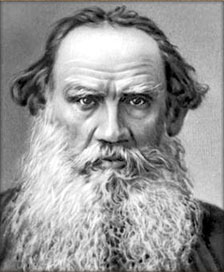Kostya struggles to find the meaning of his life after his brother Nikolai’s death from consumption, and begins to have suicidal thoughts. However, after speaking at length to a peasant, Kostya has a true change of heart, concluding that the meaning of life is to serve God, and that he does believe in the Christian principles taught to him in childhood and no longer questions his faith. He realizes that one must decide for oneself what is acceptable concerning one’s own faith and beliefs and chooses not to tell Kitty of the change that he has undergone.
A lightning storm later occurs at Kostya’s estate while his wife and newborn son are outdoors and, in his fear for their safety, Kostya realizes that he does indeed love his son as much as he loves Kitty. Kitty’s family is concerned that a man as altruistic as her husband does not consider himself to be a Christian.
Kostya is initially displeased that his return to his faith does not bring with it a complete transformation to righteousness. However, at the end of the story, Kostya arrives at the conclusion that despite his newly accepted beliefs, he is human and will go on making mistakes. His life can now be meaningfully and truthfully oriented toward righteousness.
Style and major themes
Tolstoy’s style in Anna Karenina is considered by many critics to be transitional, forming a bridge between the realist and modernist novel. According to Ruth Benson in her book about Tolstoy’s heroines, Tolstoy’s diaries show how displeased he was with his style and approach to writing in early drafts of Anna Karenina, quoting him as stating, “I loathe what I have written. The galleys of Anna Karenina for the April issue of Russkij Vestnik now lie on my table, and I really don’t have the heart to correct them. Everything in them is so rotten, and the whole thing should be rewritten—all that has been printed too—scrapped, and melted down, thrown away, renounced (1876, JI 62: 265)”.
Anna Karenina is commonly thought to explore the themes of hypocrisy, jealousy, faith, fidelity, family, marriage, society, progress, carnal desire and passion, and the agrarian connection to land in contrast to the lifestyles of the city. According to literary theorist Cornelius Quassus, in the novel Anna Karenina, “unofficial institutions of the system, presented through social salons, function as part of the power apparatus that successfully calms the disorder created by Anna’s irrational emotional action, which is a symbol of resistance to the system of social behavioral control.” Translator Rosemary Edmonds wrote that Tolstoy does not explicitly moralize in the book, but instead allows his themes to emerge naturally from the “vast panorama of Russian life.” She also says one of the novel’s key messages is that “no one may build their happiness on another’s pain.”
Levin is often considered a semi-autobiographical portrayal of Tolstoy’s own beliefs, struggles, and life events. Tolstoy’s first name was “Lev”, and the Russian surname “Levin” means “of Lev”. According to footnotes in the Pevear/Volokhonsky translation, the viewpoints Levin supports throughout the novel in his arguments match Tolstoy’s outspoken views on the same issues. Moreover, according to W. Gareth Jones, Levin proposed to Kitty in the same way as Tolstoy to Sophia Behrs. Additionally, Levin’s request that his fiancée read his diary as a way of disclosing his faults and previous sexual encounters parallels Tolstoy’s own requests to his fiancée Behrs.
Historical context
The events in the novel take place against the backdrop of rapid transformations as a result of the liberal reforms initiated by Emperor Alexander II of Russia, principal among these the emancipation reform of 1861, followed by judicial reform, including a jury system; military reforms, the introduction of elected local governments (zemstvos), the fast development of railroads, banks, industry, telegraphy, the rise of new business elites and the decline of the old landed aristocracy, a freer press, the awakening of public opinion, the Pan-Slavism movement, the woman question, volunteering to aid Serbia in its military conflict with the Ottoman Empire in 1876, etc. These contemporary developments are hotly debated by the characters in the novel.
The suburban railway station of Obiralovka, where one of the characters commits suicide, is now known as the town of Zheleznodorozhny, Moscow Oblast.
Reception
Anna Karenina’s immediate reception in the United States was mixed, with the work’s themes and eponymous character receiving praise but its length and depiction of suicide receiving criticism.
When William Faulkner was asked to list what he thought were the three greatest novels, he replied: “Anna Karenina, Anna Karenina, and Anna Karenina”.
Anna Karenin
The title has been translated as both Anna Karenin and Anna Karenina. The first instance eschews the Russian practice of employing gender-specific forms of surnames, instead using the masculine form for all characters. The second is a direct transliteration of the actual Russian name. Russian author Vladimir Nabokov explains: “In Russian, a surname ending in a consonant acquires a final ‘a’ (except for the cases of such names that cannot be declined and except adjectives like OblonskAYA) when designating a woman.”
Since surnames are not gendered in English, proponents of the first convention—removing the Russian ‘a’ to naturalize the name into English—argue that it is more consistent with English naming practice, and should be followed in an English translation. Nabokov, for instance, recommends that “only when the reference is to a female stage performer should English feminise a Russian surname (following a French custom: la Pavlova, ‘the Pavlova’). Ivanov’s and Karenin’s wives are Mrs Ivanov and Mrs Karenin in Britain and the US—not ‘Mrs Ivanova’ or ‘Mrs Karenina’.”
The practice favored by most translators, however, has been to allow Anna’s actual Russian name to stand. Larissa Volokhonsky, herself a Russian, prefers the second option, as did Aylmer and Louise Maude, who lived in Russia for many years and were friends of Tolstoy. A handful of other translators, including Constance Garnett and Rosemary Edmonds, both non-Russians, prefer the first.
